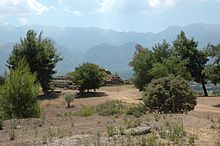Menelaion
The Menelaion (Μενελαίον) was the heroon of Menelaus and Helena near Sparta ( Peloponnese , Greece ).
The place was already settled in the Middle Helladic period (approx. 2000–1600 BC). Later a significant representative building complex of the early Mycenaean epoch was built, but it was never expanded into a Mycenaean palace like Mycenae , Tiryns or Pylos (see Palace of Nestor ). Therefore, a stage of representative architecture can be grasped here, which is not known from other Mycenaean sites because of later overbuilding. After various phases of subsequent use, the site was closed in the late 13th century BC. Destroyed by fire and abandoned. In the 8th century BC A heroon for Menelaus and Helena was built in the immediate vicinity on the edge of the terrain to the Eurotastal , which suggests that the Spartans of that time made a reference to the past via the Mycenaean building ruins and could have regarded them as the palace of the mythical king Menelaus . The sanctuary initially consisted of only one altar and was then gradually expanded. The current ruins show the last stage of expansion from the 5th century BC. Since classical times the number of consecration gifts has decreased significantly, and in the Hellenistic period one lost interest in this place of worship.
The British School at Athens carried out excavations in the Menelaion 1909-10 (under Richard MacGillivray Dawkins ) and 1973-78, 1980, 1985-86, 1988 (under Hector W. Catling ).
literature
- Christopher Mee, Antony Spawforth: Greece. To Oxford Archaeological Guide . Oxford University Press, Oxford 2001, ISBN 0-19-288058-6 , pp. 225-229.
- Hector W. Catling: Sparta: Menelaion I. The Bronze age. The British School at Athens, London 2009, ISBN 978-0-904887-59-4 .
Web links
- Panorama (QTVR)
- Report of the British School at Athens ( Memento of September 25, 2006 in the Internet Archive )
Individual evidence
- ^ RLN Barber: The Origins of the Mycenaean Palace. In: Jan Motyka Sanders (Ed.): Philolakon. Lakonian Studies in Honor of Hector Catling. British School at Athens, London 1992, ISBN 0-904887-10-3 , pp. 11-14.
Coordinates: 37 ° 3 ′ 55 " N , 22 ° 27 ′ 14" E
